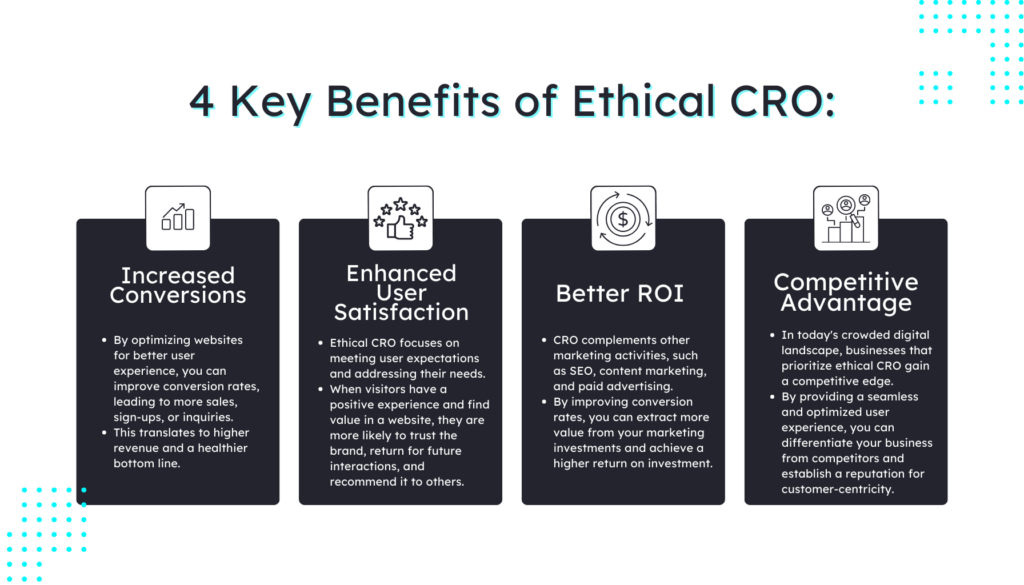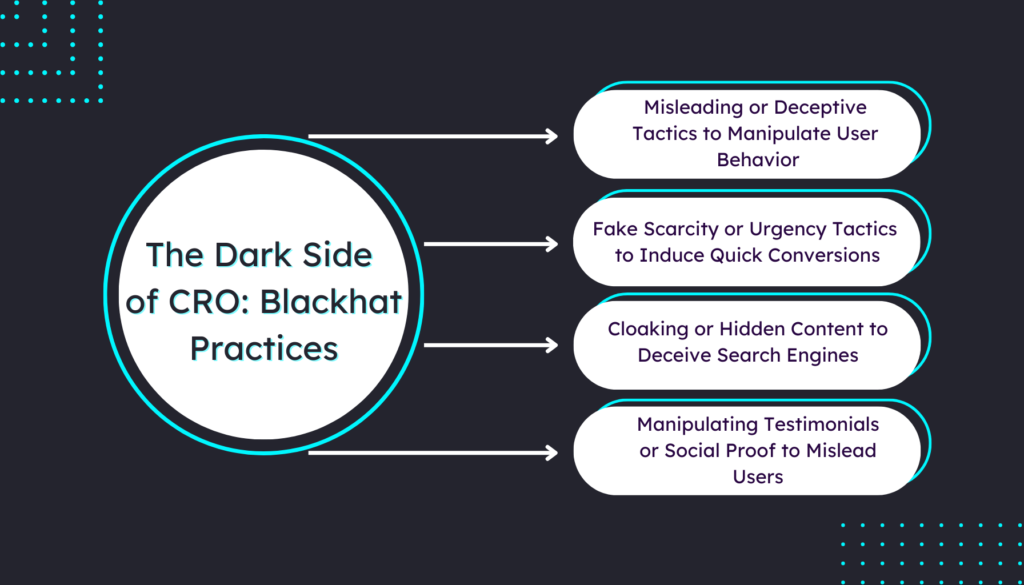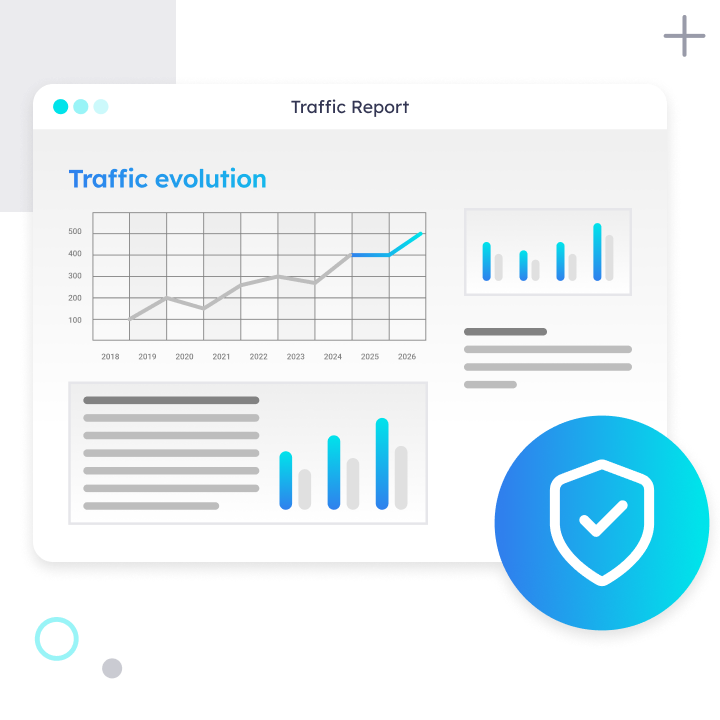
Conversion Rate Optimization (CRO) has long been hailed as the holy grail of online business success. With its ability to transform more website visitors into loyal customers, CRO has become a cornerstone of digital marketing strategies. However, lurking in the shadows of this seemingly innocuous practice lies a dark and sinister side: Blackhat CRO.
We’ll dive deep into the underbelly of Conversion Rate Optimization and uncover the hidden secrets that fuel the dark side of the industry. By understanding the risks and consequences associated with blackhat strategies, we can navigate the treacherous waters and pave the path toward sustainable growth and genuine customer satisfaction.
Understanding Conversion Rate Optimization (CRO)
Conversion Rate Optimization is a systematic approach to improving website performance by increasing the percentage of visitors who take the desired action, such as making a purchase, filling out a form, or subscribing to a newsletter. It involves analyzing user behavior, identifying areas of improvement, and implementing strategies to enhance the conversion funnel.
CRO encompasses a wide range of legitimate techniques and best practices that aim to optimize user experience and increase conversions. These techniques include:
- Data Analysis: CRO starts with data analysis, where marketers examine user behavior, conversion funnels, and key performance indicators (KPIs) to identify bottlenecks and areas for improvement. By leveraging analytics tools and user feedback, businesses gain valuable insights to guide their optimization efforts.
- Testing: Testing involves comparing two or more variations of a web page or element to determine which one performs better in terms of conversion rates. By testing different headlines, layouts, calls-to-action, or colors, you can make data-driven decisions to optimize your website and maximize conversions.
- User Experience (UX) Design: Ethical CRO prioritizes the user experience. By ensuring intuitive navigation, fast loading times, mobile responsiveness, and clear calls-to-action, you can create a seamless and enjoyable experience for visitors. User-centric design improves trust, reduces bounce rates, and increases the likelihood of conversions.
- Persuasive Copywriting: Crafting persuasive and compelling content is another crucial aspect of CRO. By understanding customer pain points, using persuasive language, and highlighting unique selling propositions, you can engage visitors and encourage them to take the desired action.
- Conversion Funnel Optimization: Mapping and optimizing the conversion funnel is crucial for improving CRO. By identifying potential drop-off points in the customer journey and streamlining the process, you can guide visitors smoothly toward conversion, reducing friction and increasing the likelihood of successful conversions.
When implemented ethically, Conversion Rate Optimization can have a significant positive impact on businesses. Here are some benefits of ethical CRO:
- Increased Conversions: By optimizing websites for better user experience, you can improve conversion rates, leading to more sales, sign-ups, or inquiries. This translates to higher revenue and a healthier bottom line.
- Enhanced User Satisfaction: Ethical CRO focuses on meeting user expectations and addressing their needs. When visitors have a positive experience and find value in a website, they are more likely to trust the brand, return for future interactions, and recommend it to others.
- Better ROI on Marketing Efforts: CRO complements other marketing activities, such as SEO, content marketing, and paid advertising. By improving conversion rates, you can extract more value from your marketing investments and achieve a higher return on investment.
- Competitive Advantage: In today’s crowded digital landscape, businesses that prioritize ethical CRO gain a competitive edge. By providing a seamless and optimized user experience, you can differentiate your business from competitors and establish a reputation for customer-centricity.

The Dark Side of CRO: Blackhat Practices
The deceptive side of optimization is characterized by the use of unethical tactics that exploit user behavior, deceive search engines, and prioritize short-term gains over the long-term trust and reputation of businesses. Some of these techniques include:
1. Misleading or Deceptive Tactics to Manipulate User Behavior
Blackhat CRO practitioners often resort to misleading or deceptive tactics to manipulate user behavior and increase conversions. This may include tactics such as:
- False Promises: Making exaggerated claims or false promises to entice visitors into taking a desired action, like promising unrealistic results or guarantees that cannot be fulfilled.
- Hidden Costs or Obligations: Concealing additional costs, recurring charges, or subscription obligations until after a user has committed to a purchase or sign-up. This can mislead users and erode trust.
- Sneaky Opt-ins: Using deceptive opt-in forms or pre-selected checkboxes to trick users into subscribing to newsletters or accepting terms without their explicit consent.
2. Fake Scarcity or Urgency Tactics to Induce Quick Conversions
It’s also usual to employ tactics that create a false sense of scarcity or urgency to manipulate users into making impulsive decisions. Examples include:
- Artificial Countdowns: Displaying countdown timers that reset or refresh whenever a page is reloaded, giving the impression of limited time availability when it may not be the case.
- Fictitious Stock Levels: Showing low stock availability or inventory scarcity to pressure users into immediate purchases, even if the stock levels are fabricated or not accurate.
- False Social Proof: Fabricating social proof indicators, such as fake reviews, testimonials, or user activity notifications, to create a sense of urgency or popularity around a product or service.
3. Cloaking or Hidden Content to Deceive Search Engines
Blackhat CRO practitioners may engage in cloaking, a technique where different content is shown to search engine crawlers and actual website visitors. This is done to manipulate search rankings and deceive search engines. Examples include:
- Keyword Stuffing: Overloading web pages with excessive keywords or irrelevant content to artificially boost search engine rankings, despite it providing little value to actual visitors.
- Hidden Text or Links: Concealing text or links within a web page by using techniques such as small font sizes, matching text, and background colors, or placing text behind images. This aims to manipulate search engines while keeping the content invisible to users.
4. Manipulating Testimonials or Social Proof to Mislead Users
Another common blackhat practice is to resort to manipulating testimonials or social proof elements to deceive users and create false credibility. Examples include:
- Fabricated Testimonials: Creating fictional testimonials or reviews to enhance product or service credibility, even though the experiences or opinions are entirely false.
- Paid Influencers: Engaging paid influencers or individuals to provide positive reviews or endorsements without proper disclosure, leads users to make decisions based on misleading recommendations.

The Gray Area of CRO: Grayhat CRO
In the realm of CRO, not all practices fall strictly into the categories of blackhat (unethical) or whitehat (ethical). There exists a gray area known as Grayhat CRO, where techniques and strategies may not be explicitly deceptive or malicious but still push the boundaries of ethical optimization.
These tactics often exploit technical loopholes and ambiguous guidelines. Or use persuasive strategies that push the limits of what can be considered fair and transparent.
Examples of grayhat CRO techniques include:
- Gamified Opt-in Forms: Implementing interactive elements, contests, or incentives within opt-in forms to increase engagement and encourage conversions. While these tactics may boost conversions, their transparency and alignment with user expectations need to be carefully assessed.
- Native Advertising Integration: Integrating paid advertisements seamlessly into website content to improve visibility and generate conversions. While disclosure is essential in native advertising, finding the right balance between promoting content and maintaining user trust can be challenging.
- Aggressive Remarketing Strategies: Implementing remarketing campaigns that involve targeting users with a high frequency of ads or using persistent tactics to re-engage them. While remarketing can be effective, overdoing it can lead to user frustration and negative brand perception.
- Exploitative Pricing Strategies: Implementing dynamic or personalized pricing strategies that capitalize on user data, browsing behavior, or user profiles. While personalization can enhance the user experience, you must be transparent and ensure that pricing practices do not discriminate or exploit users based on their personal information or characteristics.
Free template: CRO audit checklist
Discover everything you need to start identifying drop-offs and increase conversions.

Risks and Consequences of Blackhat CRO
Blackhat CRO may promise quick wins and immediate results, but the risks and negative impacts associated with engaging in such unethical practices far outweigh any short-term gains.
Damage to Brand Reputation and Customer Trust
By employing deceitful tactics, you risk tarnishing your brand reputation and eroding the trust of your customers. When visitors discover manipulative techniques, such as false promises or hidden costs, their perception of the brand can be irreparably damaged. Negative word-of-mouth, online reviews, and social media backlash can quickly spread, impacting credibility and hindering future customer acquisition.
Legal and Regulatory Repercussions
Engaging in blackhat CRO practices can expose your business to legal and regulatory risks. Misleading customers, false advertising, or violating privacy laws can result in legal action, fines, and potential lawsuits. Non-compliance with consumer protection regulations or data privacy laws can lead to severe financial penalties, not to mention the reputational harm that accompanies legal disputes.
Penalties from Search Engines and Loss of Organic Visibility
Search engines play a crucial role in driving organic traffic to websites. However, search engines actively combat manipulative tactics to maintain the integrity of search results. When search engines detect blackhat CRO techniques, websites can face severe penalties, including a drop in search rankings or removal from search engine indexes altogether. Loss of organic visibility translates into a significant reduction in website traffic and potential customers.
Negative Impact on Long-term Business Sustainability
While blackhat CRO may yield short-term gains, the long-term sustainability of a business is compromised. Ethical business practices, including transparent marketing and genuine customer relationships, are the foundation for building customer loyalty and repeat business. Engaging in unethical practices undermines this foundation and can lead to a decline in customer retention, making it difficult to maintain long-term growth and profitability.
Increase +180%
leads
demos
sales
bookings
from your website with AI
Get more conversions from your existing website traffic delivering personalized experiences.

Conclusion
In the world of CRO, it is essential that you recognize the ethical boundaries and embrace practices that prioritize transparency, user experience, and long-term sustainability.
While blackhat CRO tactics may promise quick gains, they come with significant risks and consequences that can harm your company’s reputation, trustworthiness, and overall success. By avoiding deceptive strategies and focusing on ethical CRO techniques, you can build strong customer relationships, enhance brand credibility, and achieve sustainable growth in the digital landscape.
Remember, the true power of CRO lies in creating meaningful connections with users, optimizing their experience, and delivering genuine value that fosters long-term loyalty and business success.





